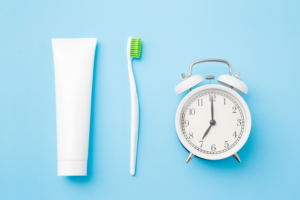Kurt Pollack, a 29-year-old operations manager, used MacroFactor to lose 32 pounds (while adding 40 pounds to his bench press!).
For Kurt, MacroFactor’s easy food logging, dynamic expenditure and weight trend calculations, and smart coaching algorithms took the stress and guesswork out of macro tracking and led to huge physical and psychological wins.
“The biggest win is just getting back to a point where I’m really happy with my body,” Kurt said.

Kurt started lifting when he was 20, and – after seeing the benefits of lifting and nutrition management – went back to school to get a degree in dietetics and nutrition. When he started tracking his nutrition, he first did so manually with a pen and paper, then with MyFitnessPal.
In February 2020, he started a new, demanding job and his weight began creeping up.
“I was using MyFitnessPal and seeing zero success – my weight would fluctuate, but I could never get a downward trend going,” he said.
He tried another popular diet coaching app a couple of times, but found that the rigidity and notifications left him feeling judged.
“That was even worse than MyFitnessPal. MFP was just a tracker (I always ignored the recommended macros), but the way [the other diet coach app] pigeonholed me into eating specific macros at specific times throughout the day both drove me crazy and made me feel I was doing something wrong,” Kurt said.
He spent two years fluctuating between 242 and 250 pounds, knowing he’d feel better and more confident if he could lose weight, but unable to do so.
“I was so frustrated,” he said. “I have a degree in nutrition with some post-grad study under my belt. I did some basic personal training for a wide range of clients while I was a student. Why couldn’t I apply this knowledge to myself?”
Then, he saw a post about MacroFactor on social media and knew he had to try it.
“I got the free trial and two days later bought the year membership,” Kurt said. “I was fascinated by the idea that I could get regular updates on my expenditure just by doing the same logging I had been doing for years.”
His heaviest weigh-in was 252 pounds, which was about two weeks before he started using MacroFactor in spring 2022. By October 2022, he was down to 220 pounds.
“I’ve lost 24 pounds off my trend weight and 32 pounds since my lifetime-highest scale weight earlier this year,” he said. “I feel much more confident that tracking my intake with MF is going to actually give me results, because I have the expenditure output to go with it.
“I have maintained my powerlifting maxes (485 deadlift and 330 back squat) and actually increased my bench press max from 235 pounds to 275 pounds while cutting more than 10% of my bodyweight.”

Kurt shared a few details about how he set up his diet in MacroFactor:
- He uses a collaborative program. For his first few months, he kept his macro and calorie targets even across all days. Lately, though, he’s added ~400 calories to Saturday and Sunday while removing the remaining calories evenly from his work days.
- His primary focus is protein and calories, but he tries to get 300g of carbs for performance and 30-40g of fiber for gut health. He also tries to minimize regular intake of highly processed foods and sweets, but will carve out calories in his day for such foods from time to time.
- He set his weight loss goals in MacroFactor 10 pounds at a time.
- He weighs himself daily.
- He takes advantage of the easy custom recipe creation in MacroFactor when meal prepping. He adds up all the total ingredients, takes a total weight of the finished product, and then weighs each serving.
After struggling to make progress with other macro tracking and diet coach apps, Kurt cited three unique MacroFactor features that finally helped him achieve his goal.
MacroFactor’s adherence neutral, anti-shaming philosophy:
Kurt appreciated that he didn’t have to perfectly adhere to his targets to get program updates, and that MacroFactor never shamed him for the choices he made.
“I’m going to overeat sometimes, and I’m going to undereat sometimes,” Kurt said. “I don’t like to feel like I’m being punished for it, because I punish myself enough for overeating. It’s great to have a tool that doesn’t ‘judge’ me.”
MacroFactor’s best-in-class energy expenditure calculation:
MacroFactor keeps pace with user’s ever-changing energy needs and updates their expenditure estimate as needed to ensure that their calorie targets are appropriate for their goals.
“Having an accurate running estimate of my expenditure and weekly check-ins not only helps me strategize my nutrition, but it really makes me think about everything else,” Kurt said.
“How has my sleep been? What’s my NEAT look like? How are my workouts going? I gained weight the last two winters and I chalked it up to holiday overeating, but this year I saw my expenditure drop precipitously the week after Daylight Savings and cold winters set in. That gave me a lot of clarity.”

MacroFactor’s unique Weight Trend metric:
The weight trend feature in MacroFactor highlights meaningful changes in weight, free from large swings due to transient weight fluctuation.
“I still get a little emotionally attached to the scale sometimes, and if I have a big meal (I may not have even exceeded my calories, but if I have a lot of salt and starch at dinner), my scale weight can easily jump 3-4 pounds in a day,” Kurt said. “It’s very helpful to have [the Weight Trend metric] to interrupt those negative thoughts.”

“The biggest difference is that MacroFactor feels like an AI partner, instead of just a tracking log,” Kurt said. “It is a great tracking log, but it’s so much more than that, for all three reasons listed above. I trust it as a source of data and input, where MyFitnessPal was just a log, and [other diet coach apps] tried to push me to eat in ways I didn’t want to.”
After reaching his weight loss goal in October, Kurt shifted to a maintenance goal in MacroFactor.
“I’m going on 3 months of nearly perfect maintenance,” Kurt said. “This is the most stable I’ve ever been after a successful cut.”
He’s planning to stay at maintenance for a few more months, then lose about 10 more pounds during a short cut in the spring.
After that, he’s planning to start a slow, lean bulk.
“My goal for the next few years is to get to 225 pounds while being a little bit leaner than I am now, which will require 15-20 pounds of lean mass,” he said.

To conclude our interview, we asked Kurt if he had any advice to other MacroFactor users who have similar goals. He provided four great, thorough points that we’ll re-print in full below:
“Be diligent with your tracking, but don’t be afraid to take breaks. My fiancee and I are trying to travel as much as we can, and I don’t track during those times. It can be hard to disconnect, but MacroFactor makes it seamless to just pick up and run with it when you get back (or just start tracking again).
“Use a step and sleep tracker if you have one. I don’t put any weight in the estimated calories burned or calories from exercise that my Garmin tracks, but having a reliable step counter is very important for me to manage my NEAT. Garmin also tracks heart rate and sleep, both of which give you an estimated stress rating for the day, which I’ve found helps me schedule breaks from hard lifts when I see multiple days in a row of high stress.
“Find routines where you can. My daily eating schedule and meals change regularly, but I have a morning routine that I’ve been using for two years that works very well for me to get ready for the day – wake up, drink a glass of water, have a cup of coffee, go for a walk, lift, have a protein shake, and THEN my day starts. This really sets me up for a better day and I notice that I feel off when I don’t do it.
“While I don’t believe in extreme restriction, be comfortable setting boundaries. If you’re out with friends and want to limit yourself to a certain number of drinks, or don’t want to eat something specific, do it. If someone asks if you want to split an order of wings and you don’t trust yourself not to eat the half dozen and order more, politely decline. You can explain your reasoning if you want, but you’re not beholden to anyone to do that. Your goals and boundaries are yours.”
If you’d like to connect with Kurt and follow his training, you can find him on Instagram.
Try MacroFactor for yourself with a 7-day free trial
Confidently control your nutrition with MacroFactor, a science-backed diet coach and macro tracker app that empowers you with the tools you need to reach your goals without rigidity.
You can try it free for 7 days on the App Store or Google Play, or learn more here.
Do you have a MacroFactor success story?
We love to learn about, celebrate, and share MacroFactor users’ success. If you’re interested in your story being featured as a MacroFactor case study, you can learn more and submit your story here.





